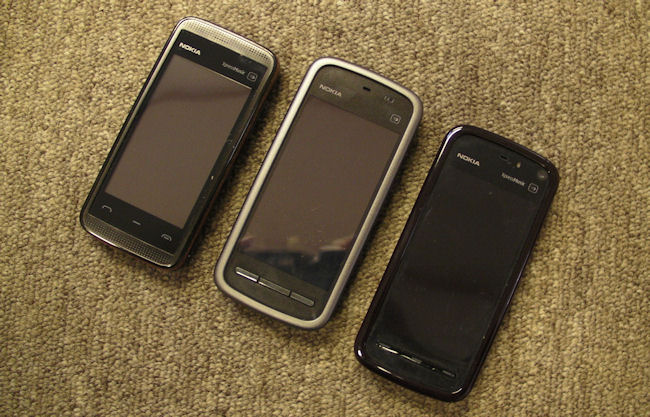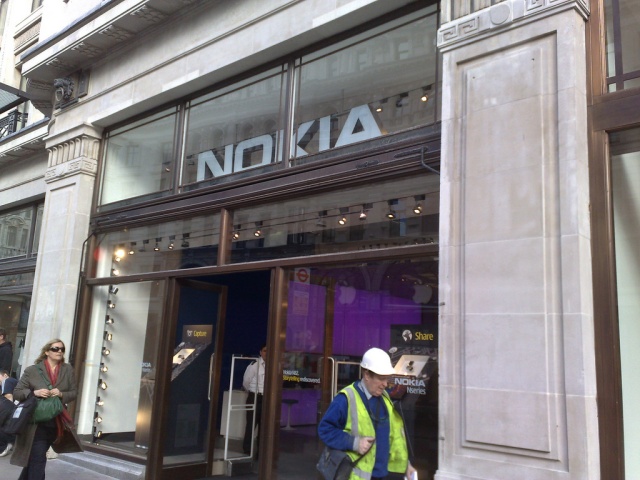The first point to note is that the big news in mobile la-la land at the moment is from America, where the iPhone will be available on another network, namely Verizon. (Oh and it has “personal hotspot”, or what I prefer to call… Joikuspot).
The second is the news from T-Mobile (UK) that they’re dropping their “unlimited” data plans down to a fair use 500MB/month limit, which has a lot of people up in arms, even though the numbers show around 98% of users use of the order of 200MB a month.
Both of these serve to show not only the power that the mobile networks have in deciding what end-users can do with their phones, but also that once you get out of the rarefied atmosphere of SIM-free phones, marketing samples and just going out and buying a handset, real world issues have a huge impact on both the users and the handset manufacturers.
And that includes the marketing presence of the networks. The big burst of interest in the Apple iPhone is not because of the hardware (a new signalling system) or the one new tweak in software (in the hotspot), but the interest is that it’s going to be available on a specific network, in this case Verizon.
For all the fighting and discussion over which Operating System is best, the vital role that networks play is usually pushed to the side. It’s fair to say that the handsets we review here on All About Symbian are rarely exactly the same as what you’ll pick up in the shops. For example, when I was touring the US last year with a Nokia 5230, unless you went direct, US readers would be picking up the T-Mobile badged version called the Nuron.

Nokia 5530, 5230 and 5800
It’s most noticeable in America, but the networks (who provide the vast majority of handsets into the retail market) are one of the factors that can have a huge impact on smartphones. Like any business, they need to maximise their value for shareholders, and in general that means keeping the bottom line on the balance sheet in profit. A mix of keeping costs as low as possible, while bringing as much income as possible is the rule.
So the dropping of the data rate from T-Mobile reduces a cost (the bandwidth needed to shift around data) and potentially bringing in some extra cash from the heavy duty users. While it’s not been announced, allowing a Verizon iPhone to be a hotspot is likely to be an extra fee (perhaps around $20). Decisions of that nature are behind my handset choices (in a negative way!)
You can be sure that T-Mobile in the USA saw the lower amount of data transferred on the Nuron compared to other smartphone handsets in the $150 range and that was part of the calculation on whether to carry the handset.
And here’s why Nokia have never “broken” America. In all the discussions with their four major customers in America (Verizon, Sprint, T-Mobile and AT&T), they’ve never been able to put together a package that’s attractive to the bottom line for the networks. Whether that’s because of the unit cost on handsets, an unwillingness to compromise on some of the software, or other reasons, is one for the analysts, but without getting in the door, Nokia couldn’t do an end run and go direct to customers in the US or anywhere else in the world. They did try though.

Nokia London Storefront, by nechbi.
Compare this to the huge number of variants available in the UK and Europe – the 5228 being a great example of a smartphone that feels “built to order” for a spot in one network’s catalogue. Symbian OS is finally starting to get credit as being a great and capable OS (but a few more iterations are needed so some people can admit it without prejudicing their older reporting), the hardware in the handsets is rightly acknowledged as being far and away some of the best on a mobile device, and it hits the basic requirements of battery life, talk time and communicating out of the park.
But those are side issues to the real path to success.
As the smartphone market moves towards ubiquity, the ability to trade large numbers of handsets, tailored to each network, is going to be vital. One of Nokia’s strengths in using Symbian is the ability to turn out hundreds of custom firmwares for each network and deliver what they’ve been asked to deliver, on time, and with all the economies of scale they can address.
Understanding the carrier is one of their “golden eggs.” It’s not something that Apple have to deal with thanks to their magic halo, and to a certain extent Google pass the buck to white label manufacturers like ZTE and HTC to do the network liaison. Nokia control the entire chain from inception to delivery at the warehouse.
That makes them attractive and it’s one reason why they’re still commanding huge market share – they’re delivering what the customer wants. The customer being the network. And those networks have the relationship with the public that allow them to sell these phones.
Most people on the street know who they sign their contract with. Nokia are fully aware of the need to keep that relationship as healthy as possible. So while lots of words are being written about processor speeds, memory, storage and megapixels, it’s nice to see everyone talking about what really matters.
If only for a day.
-- Ewan Spence, Jan 2011.
